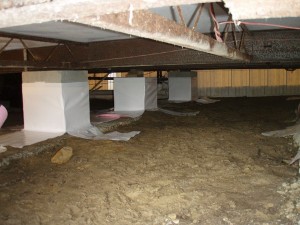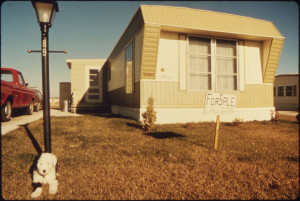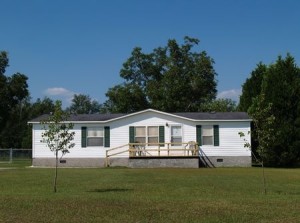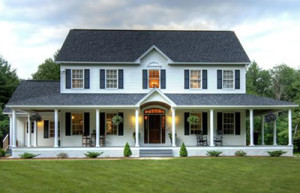I wonder if Sammy Kershaw knew he was using improper terminology. Maybe it’s because “She’s the queen of my double wide manufactured home” just didn’t roll off the trailer tongue. So, whats the deal? Is there a difference between the term , Mobile/Trailer home, manufactured home, and modular? In the short of it, a heck of a big difference–the 80′ of it is below.
The Mobile/Trailer Home
The big key is here is built prior to 1976. If it’s on wheels (or had wheels permanently affixed) and it was built before 1976–it’s a mobile. Why is 1976 important? In 1976, HUD established the Manufactured Home Construction and Safety Standards (MHCSS), commonly known as the HUD code. These federal standards regulate all aspects of construction, including design and construction strength, durability, trans-portability, fire resistance, and energy efficiency.
Manufactured Home
Leave it to the Feds to say it best, “Manufactured homes are built as dwelling units of at least 320 square feet (30 m2) in size with a permanent chassis to assure the initial and continued trans-portability of the home.” The key here is permanent chassis. What’s that mean–normally it means a metal frame. Let’s contrast the crawl space of a stick built home with one of a manufactured home.

Note the metal floor joists and framing–metal frame=manufactured home (or a mobile/trailer home if the structure was constructed prior to 1976). There are some really strange exceptions to this rule–but for brevity, if you know of an exception in Vernon County Missouri, comment below…..I wanna see it!

Wood framing means one of two types of construction–either a modular or a conventional stick built home.
Personally, I’ve lived a couple of years a manufactured single wide–my review was purely positive. It was affordable, energy efficient, and it had a huge deck (it did not have polyester curtains, and the deck was made out of pressure treated pine–not to be confused with Sammy’s redwood). There are some cons to this type of construction, mainly financing, value retention, and useful life but we’ll hit on some of that later.
Modular Homes
Now, I might have went a little right field on this one. I’m a little biased here as well–I was raised in a modular home. I favor this type of construction. This is truly a modular home pictured however.
What’s a modular you ask? A modular home is one that is built off-site in a factory controlled environment, and then assembled on site by a builder. Basically, it’s a stick built home, just not built on site. Some modular homes look very closely to manufactured homes, but some are very extravagant–like the one pictured above.
Pro’s of a modular home? Probably the largest is the fact that it was built in a controlled environment. If you’ve ever built a wood frame structure in April in Missouri, you know what I mean. 2×4’s and OSB board hate water and weather–the modular concept really rids some of this concern. The second is the home is built to normally a stringent code, inspected during the build process etc–If you stick build a home outside the city limits in Vernon County Missouri, these spot inspections aren’t conducted by a third party….with a modular you get that reassurance.
Cons of a modular home? Market stigma…..People sometimes have trouble separating categories that I’m blogging about. They remember the early 1970’s mobiles in the same category as today’s modulars…..not so folks, not even comparable.
Again, how to tell if it’s manufactured or modular–the framing is the dead give away. If it’s wood frame, it’s stick built or modular. If it has metal, its normally a manufactured or mobile home. If in doubt–it’s always safe to contact a professional home inspector.
Financing?
Please note, this could be a complete other blog, but I’ve tried to condense as much as possible.
Mobile Homes–Have your checkbook ready! As for a secondary market fixed rate long term loan….good luck. I’m sure there’s someone out there that claims they do it, but I have never seen it.
Your best bet here is what I refer to as collateral lenders–the banks of old. The local home town folk. A collateral position of 80% LTV is probably your best case scenario. Appraisers frown on this type of construction too. You better hope you have some value in the ground, as the improvements won’t carry you too far.
Manufactured homes– According to HUD, many options low down options exist. FHA, VA, USDA, but again, finding a lender that will write one is tricky. Many lenders have overlay restrictions that are more stringent than the HUD restrictions that are in place. Why do lenders do this? Lenders sell loans. Investors buy loans–many investors frown on the value retention of manufactured homes. Is it possible to get an FHA, VA or USDA loan on a manufactured? The short of it is FHA–yes, but it’s really hard. USDA–no, unless it’s new. VA–same story as FHA. The long of it, is a much longer blog. Call me for details.
Modular homes– This one is treated the same as a stick built by most lenders and it’s not a huge deal. The key is though making sure that it is a true modular. I’ve seen other Realtors mis-advise clients and make it to the appraisal stage, only to be denied and charged a huge application fee. Wood frame again is the main deal!



